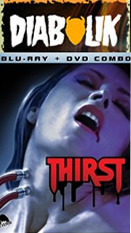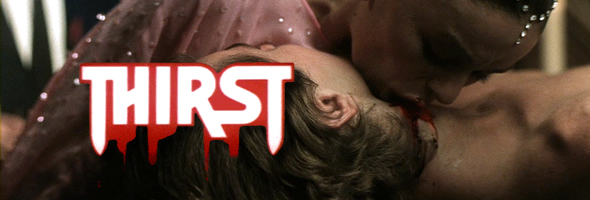
Color, 1979, 95 mins. 38 secs.
Directed by Rod Hardy
Starring Chantal Contouri, Shirley Cameron, Henry Silva, David Hemmings, Max Phipps
Indicator (UHD & Blu-ray) (US/UK R0 4K/HD), Severin Films (Blu-ray & DVD) (US R0 HD/NTSC), Synapse Films, Elite Entertainment (DVD) (US R0 NTSC) / WS (2.45:1) (16:9)
Spurred on by the 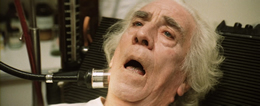 success of Anne Rice's Interview with the Vampire and a resurgence of interest in
success of Anne Rice's Interview with the Vampire and a resurgence of interest in 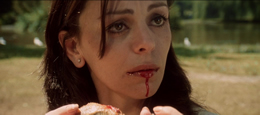 Dracula and his very debatable real-life influence, Vlad the Impaler, everyone went on a mad vampire binge in the late '70s. Nowhere was this more evident than the year 1979, with movie theaters crowded with bloodsucking films ranging from the serious (Herzog's Nosferatu and Badham's Dracula) to the silly (Love at First Bite, Nocturna) and even flat-out misleading (Nightwing). Tucked away among these was Thirst, an Australian stab at vampire lore with a modern scientific/industrial slant, foreshadowing a number of other modern spins still to come decades later (most obviously Daybreakers and TV's True Blood).
Dracula and his very debatable real-life influence, Vlad the Impaler, everyone went on a mad vampire binge in the late '70s. Nowhere was this more evident than the year 1979, with movie theaters crowded with bloodsucking films ranging from the serious (Herzog's Nosferatu and Badham's Dracula) to the silly (Love at First Bite, Nocturna) and even flat-out misleading (Nightwing). Tucked away among these was Thirst, an Australian stab at vampire lore with a modern scientific/industrial slant, foreshadowing a number of other modern spins still to come decades later (most obviously Daybreakers and TV's True Blood).
Plagued by nightmares in which she finds herself in a coffin, Kate Davis (Contouri) seems to have a feeling that her seemingly normal life with boyfriend Derek isn't all it appears to be. That includes opening a carton of milk to find it filled with a blood, which turns out to be the precursor to a kidnapping attempt by an underground organization called the Brotherhood. As it turns out, there are thousands of vampires around the world with their own industrialized structure, which involves harvesting a blood supply from so-called blood cows kept in captivity. The local overseers (Hemmings, Silva, Cameron and Phipps) have different philosophies about how to move forward with Kate, who happens to be the 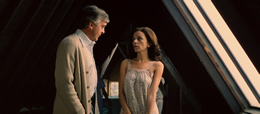 direct descendant of the infamous Countess Elizabeth Bathory and therefore a sort of queen to lead them onward. However, Kate's less than enthusiastic about being the chosen one, which inspires some of the vampiric officers to resort to mind manipulation to get her to comply with her bloody fate.
direct descendant of the infamous Countess Elizabeth Bathory and therefore a sort of queen to lead them onward. However, Kate's less than enthusiastic about being the chosen one, which inspires some of the vampiric officers to resort to mind manipulation to get her to comply with her bloody fate. 
Among the slickest and creepiest of the golden age Australian horror cycle, Thirst benefits from some inventive scope compositions throughout with characters often arranged in striking geometric patterns. The actual violence level is fairly low considering the amount of plasma spilled throughout its running time, but the decision to contrast the cold, metallic ambiance of the blood farm with the darker Gothic atmosphere of the rest of the Brotherhood's domain was a smart one. Add to that some borderline experimental narrative techniques in the midsection during the heroine's psychological upending and you have a film that still feels unpredictable and fresh, with committed performances carrying it over what could have been some narrative bumpy patches. It's always great to see Silva, of course, and Contouri makes an unusual heroine mixing fragility and possibly instability; however, Hemmings really gets top honors here as he gets to walk a very ambiguous line until the very last scene. In what seems like his thousandth score of the decade, composer Brian May also does some of his best work here with a lush orchestral score that 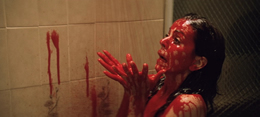 mostly hits all the right emotional notes.
mostly hits all the right emotional notes.
That aforementioned scope photography was a big stumbling block for this film's potential audiences over the years once it hit home video, with the domestic New Line prints getting diced into nonsensical squares for the '80s VHS release. Overseas it didn't fare any better 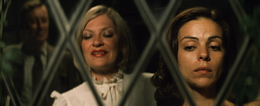 until a 2003 DVD release from Elite Entertainment that finally restored the film to a much wider 2.35:1 aspect ratio, making it enjoyable for the first time in decades. The film was also added to its three-disc Aussie horror set along with Strange Behavior (a.k.a. Dead Kids) and Patrick, then reissued along with those same titles by Synapse in 2008. All versions included an entertaining audio commentary with director Rod Hardy and producer Anthony I. Ginnane (a familiar name from many subsequent chat tracks and DVD interviews), who discuss the state of the filmmaking industry at the time which allowed for a great deal of creative freedom but not the richest financial resources. Other bonuses included the New Line theatrical trailer and a trio of TV spots, plus a Spanish audio track and an isolated May score track. Those same supplements were carried over to the dual-format Blu-ray and DVD edition from Severin Film released in 2014, but not surprisingly, the transfer showed off how far technology came in just a bit over a decade. The DTS-HD mono audio sounds more robust, of course, while the transfer improved with deeper black levels and featured a strong beige and gold appearance (more on that below).
until a 2003 DVD release from Elite Entertainment that finally restored the film to a much wider 2.35:1 aspect ratio, making it enjoyable for the first time in decades. The film was also added to its three-disc Aussie horror set along with Strange Behavior (a.k.a. Dead Kids) and Patrick, then reissued along with those same titles by Synapse in 2008. All versions included an entertaining audio commentary with director Rod Hardy and producer Anthony I. Ginnane (a familiar name from many subsequent chat tracks and DVD interviews), who discuss the state of the filmmaking industry at the time which allowed for a great deal of creative freedom but not the richest financial resources. Other bonuses included the New Line theatrical trailer and a trio of TV spots, plus a Spanish audio track and an isolated May score track. Those same supplements were carried over to the dual-format Blu-ray and DVD edition from Severin Film released in 2014, but not surprisingly, the transfer showed off how far technology came in just a bit over a decade. The DTS-HD mono audio sounds more robust, of course, while the transfer improved with deeper black levels and featured a strong beige and gold appearance (more on that below).
In 2025, Indicator released  separate UHD and Blu-ray editions in the U.S. and U.K. with their usual luxurious packaging as a limited edition with an 80-page book with a new essay by Diane A Rogers, excerpts from Ginnane’s unpublished memoirs, and archival interviews with Contouri, Hemmings and Silva. Of their Aussie upgrades to date, this one is the most dramatic with a far more robust and satisfying color gamut than any prior release. The UHD wins thanks to the HDR10-compatible Dolby Vision giving it some extra punch and
separate UHD and Blu-ray editions in the U.S. and U.K. with their usual luxurious packaging as a limited edition with an 80-page book with a new essay by Diane A Rogers, excerpts from Ginnane’s unpublished memoirs, and archival interviews with Contouri, Hemmings and Silva. Of their Aussie upgrades to date, this one is the most dramatic with a far more robust and satisfying color gamut than any prior release. The UHD wins thanks to the HDR10-compatible Dolby Vision giving it some extra punch and  depth, but the Blu-ray is also a radical leap forward as you can see below. The DTS-HD MA English mono track is in perfect shape as always (with optional English SDH subtitles), plus an LPCM 2.0 track of the film's isolated score in stereo. The 2022 Ginnane interview "Thirst: A Contemporary Blend" (13m52s) is a more general overview of the film's development as a modern take on vampirism and its links to the personnel from Harlequin and other productions including Hemmings. Then you get outtake interview footage from the filming of Mark Hartley's Not Quite Hollywood with Hardy (13m32s), Ginnane (15m11s), actor Rod Mullinar (6m21s), and cinematographer Vincent Monton (4m54s) chatting about the arduous physical demands of the production, the cold conditions in Melbourne during the winter, the casting process, the contrast in Hemmings as an actor versus a director (and the role of his alcoholism), and the execution of the special effects. Hemmings himself turns up for a funny 1979 TV interview on the local program The Don Lane Show (15m55s) including an amusing opener from a certain beloved Jane Fonda sci-fi movie, followed by a '79 audio interview with Contouri for Aussie radio (23m48s) about her thoughts on her role and the film. A 2019 Film Buffs Forecast audio interview with Hardy, Hartley, and Paul Harris (154m1s) is a very detailed, career-spanning interview charting pretty much everything you could want to know about the filmmaker's career. "Seeing Reality" (3m36s) is a quick interview with late stunt man Grant Page about the execution of the helicopter feats from the climax and the cinematic aversion to doing something like that, and finally "First Blood" (17m56s) is an appreciation by Aussie film academic Stephen Morgan about the film's unique qualities in bloodsucker and Australian cinema at a pivotal point for monster movies and blockbusters. Also on the disc are the Australian and U.S. trailers, three TV spots, and separate galleries for promotional material (110 images), behind the scenes photos (122 photos), and the dialogue continuity script (19 images).
depth, but the Blu-ray is also a radical leap forward as you can see below. The DTS-HD MA English mono track is in perfect shape as always (with optional English SDH subtitles), plus an LPCM 2.0 track of the film's isolated score in stereo. The 2022 Ginnane interview "Thirst: A Contemporary Blend" (13m52s) is a more general overview of the film's development as a modern take on vampirism and its links to the personnel from Harlequin and other productions including Hemmings. Then you get outtake interview footage from the filming of Mark Hartley's Not Quite Hollywood with Hardy (13m32s), Ginnane (15m11s), actor Rod Mullinar (6m21s), and cinematographer Vincent Monton (4m54s) chatting about the arduous physical demands of the production, the cold conditions in Melbourne during the winter, the casting process, the contrast in Hemmings as an actor versus a director (and the role of his alcoholism), and the execution of the special effects. Hemmings himself turns up for a funny 1979 TV interview on the local program The Don Lane Show (15m55s) including an amusing opener from a certain beloved Jane Fonda sci-fi movie, followed by a '79 audio interview with Contouri for Aussie radio (23m48s) about her thoughts on her role and the film. A 2019 Film Buffs Forecast audio interview with Hardy, Hartley, and Paul Harris (154m1s) is a very detailed, career-spanning interview charting pretty much everything you could want to know about the filmmaker's career. "Seeing Reality" (3m36s) is a quick interview with late stunt man Grant Page about the execution of the helicopter feats from the climax and the cinematic aversion to doing something like that, and finally "First Blood" (17m56s) is an appreciation by Aussie film academic Stephen Morgan about the film's unique qualities in bloodsucker and Australian cinema at a pivotal point for monster movies and blockbusters. Also on the disc are the Australian and U.S. trailers, three TV spots, and separate galleries for promotional material (110 images), behind the scenes photos (122 photos), and the dialogue continuity script (19 images).
Updated review on April 7, 2025
![]()
